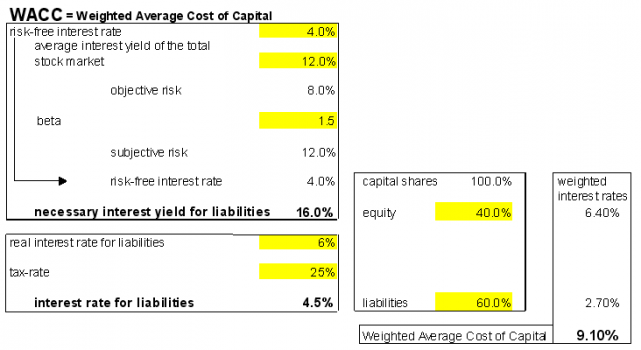Weighted Average Cost of Capital WACC
From ControllingWiki
IGC-DEFINITION (abbreviated)
Weighted Average Cost of Capital WACC / Kapitalkostensatz WACC
The Weighted Average Costs of Capital are calculated to simulate an interest rate that corresponds to market interest rates. The assumption is that the risk to invest into a company’s equity can be quantified by comparison with respective interest rates in the market. Two types of risk are distinguished:
- The risk to invest in the stock market (objective risk)
- The risk to invest in shares of a given company (subjective risk).
The objective risk is the difference between a risk-free interest rate (usually the interest rate for a government bond with guaranteed payment of interest and amortisation at the end of the bond loan) and the expected interest yield of the average stock market (price gains and dividends). These rates are calculated regularly through banks and stock exchange institutions, e.g. Swiss Performance Index.
The same institutions also calculate the Beta-factor (in short „beta“), which is used to judge the subjective risk. Beta shows – simplified – how much the stock price of a given company goes up or down, when the total market index changes by one percentage point. Beta is thus a measure for the volatility of a title.
Betas are not only calculated for companies quoted on a stock exchange but also by banks so that they can judge small and medium companies. These betas are usually available on request.
The result of the multiplication of the objective market risk with the subjective risk of the title plus the risk-free interest rate is the market-oriented interest rate for the equity of this company after tax.
Now the cost of interest for debts has to be calculated. Starting point is the actual interest rate paid today by the company. This rate has to be reduced to the interest rate after taxes. This is because interests paid for debts are deductible as expenses from the taxable income, therefore they generate tax savings when compared to financing with equity (so called tax shield). This is why the interest rate has to be reduced by the appropriate tax rate of the country.
Finally the resulting interest rates for equity and liabilities have to be weighed according to the estimated future ratio between equity and debt liabilities.
from: IGC-Controller-Wörterbuch, International Group of Controlling (Hrsg.)

